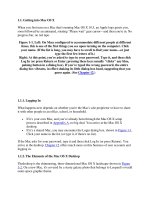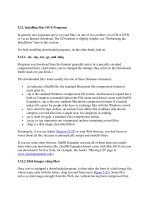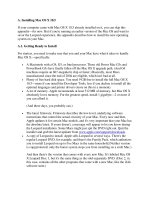Mac OS X Server Introduction to Command-Line Administration Version 10.6 Snow Leopard phần 1 pptx
Bạn đang xem bản rút gọn của tài liệu. Xem và tải ngay bản đầy đủ của tài liệu tại đây (313.3 KB, 10 trang )
Mac OS X Server
Introduction to Command-Line
Administration
Version 10.6 Snow Leopard
Apple Inc. K
© 2009 Apple Inc. All rights reserved.
Under the copyright laws, this manual may not
be copied, in whole or in part, without the written
consent of Apple.
The Apple logo is a trademark of Apple Inc., registered
in the U.S. and other countries. Use of the “keyboard”
Apple logo (Option-Shift-K) for commercial purposes
without the prior written consent of Apple may
constitute trademark infringement and unfair
competition in violation of federal and state laws.
Every eort has been made to ensure that the
information in this manual is accurate. Apple is not
responsible for printing or clerical errors.
Apple
1 Innite Loop
Cupertino, CA 95014
408-996-1010
www.apple.com
Apple, the Apple logo, AppleScript, FireWire, Keychain,
Leopard, Mac, Mac OS, Quartz, Safari, Xcode, Xgrid, and
Xserve are trademarks of Apple Inc., registered in the
U.S. and other countries.
Apple Remote Desktop, Finder, and Snow Leopard are
trademarks of Apple Inc.
AIX is a trademark of IBM Corp., registered in the U.S.
and other countries, and is being used under license.
The Bluetooth® word mark and logos are registered
trademarks owned by Bluetooth SIG, Inc. and any use
of such marks by Apple is under license.
This product includes software developed by the
University of California, Berkeley, FreeBSD, Inc.,
The NetBSD Foundation, Inc., and their respective
contributors.
Java™ and all Java-based trademarks and logos
are trademarks or registered trademarks of Sun
Microsystems, Inc. in the U.S. and other countries.
PowerPC™ and the PowerPC logo™ are trademarks
of International Business Machines Corporation, used
under license therefrom.
UNIX® is a registered trademark of The Open Group.
Other company and product names mentioned herein
are trademarks of their respective companies. Mention
of third-party products is for informational purposes
only and constitutes neither an endorsement nor a
recommendation. Apple assumes no responsibility with
regard to the performance or use of these products.
019-1398/2009-08-01
5 Preface: About This Guide
5 What’s in This Guide
6 Using Onscreen Help
7 Documentation Map
7 Viewing PDF Guides Onscreen
8 Printing PDF Guides
8 Getting Documentation Updates
9 Getting Additional Information
10 Chapter 1: Introduction to the Command-Line Environment
11 The Command-Line Environment
11 UNIX
11 The Shell
11 Accessing the Shell
11 Local Access
13 Remote Access
13 Closing the Shell
13 Executing Commands and Running Tools
14 Terminating Commands
15 Specifying Files and Folders
16 Commands Requiring Root or Administrator Privileges
16 Getting Help for Command-Line Tools
16 Using Help Built Into Command-Line Tools
17 Using Man Pages
18 Using Info Pages
19 Chapter 2: Using the Command-Line Shell Interactively
19 Standard Pipes
20 Redirecting Input and Output
20 Correcting Typing Errors
21 Using Environment Variables
22 Repeating Commands
22 Including Paths Using Drag and Drop
3
Contents
4 Contents
23 Chapter 3: Scripting the Command Line
23 What is a Shell Script?
24 Monitoring and Restarting Critical Services with launchd
25 Scheduling a Shell Script to Run at Specic Times
26 Scheduling tasks with launchd
27 Chapter 4: Connecting to Remote Computers
27 SSH
27 How SSH Works
28 Generating Key Pairs for Key-Based SSH Connections
30 Updating SSH Key Fingerprints
31 An SSH Man-in-the-Middle Attack
32 Controlling Access to SSH Service
32 Connecting to a Remote Computer Using SSH
33 Apple Remote Desktop
33 X11
34 Chapter 5: Common Command-Line Tasks
34 Editing Conguration Files
34 Text Editors
36 Saving Text Files for UNIX Execution
36 Editing Property Lists
39 Moving and Copying Files
40 Compressing and Uncompressing File Archives
40 Viewing File Contents
41 Searching for Text in a File
41 Backing Up and Restoring
42 Chapter 6: Accessing Apple Hardware from the Command Line
42 Restarting a Computer
42 Automatic Restart
43 Changing a Remote Computer’s Startup Disk
43 Shutting Down a Computer
43 Shutting Down While Leaving the Computer On and Powered
44 Manipulating Open Firmware NVRAM Variables
44 Remotely Controlling the Xserve Front Panel
45 Appendix Command-Line Tools Specic to Mac OS X
45 Section 1 Man Pages
50 Section 4 Man Pages
50 Section 5 Man Pages
51 Section 7 Man Pages
51 Section 8 Man Pages
56 Index
5
This guide provides a starting point for administering
Mac OS X Server using command-line tools.
Introduction to Command-Line Administration supplements the information in the other
advanced administration guides. It provides information useful to building workows
and remote administration practices beyond the use of Server Admin and Workgroup
Manager. The information in this guide isn’t specic to any particular technology, but
is relevant to many server technologies.
What’s in This Guide
This guide includes the following sections:
Chapter  1, “Introduction to the Command-Line Environment,” provides an overview
of the command-line environment in Mac OS X Server—for administrators who
are new to the command line or who are coming from the command line on other
platforms.
Chapter  2, “Using the Command-Line Shell Interactively,” explains how shells work
and provides information about the shells in Mac OS X Server.
Chapter  3, “Scripting the Command Line,” explains what shell scripts are and why
you would use them in Mac OS X Server.
Chapter  4, “Connecting to Remote Computers,” provides information about various
ways to access remote computers.
Chapter  5, “Common Command-Line Tasks,” provides examples of frequently used
command-line tasks.
P7-8Chapter  6, “Accessing Apple Hardware from the Command Line,” provides
information about accessing hardware-specic Mac attributes from the command line.
Appendix  , “Command-Line Tools Specic to Mac OS X,” provides a list of the
command-line tools that are unique to Mac OS X and Mac OS X Server.
Note: Because Apple periodically releases new versions and updates to its software,
images shown in this book may be dierent from what you see on your screen.
Preface
About This Guide
6 Preface About This Guide
Using Onscreen Help
You can get task instructions onscreen in Help Viewer while you’re managing
Snow Leopard Server. You can view help on a server, or on an administrator computer.
(An administrator computer is a Mac OS X computer with Snow Leopard Server
administrator software installed on it.)
To get the most recent onscreen help for Mac OS X Snow Leopard Server:
Open Server Admin or Workgroup Manager and then: m
Use the Help menu to search for a task you want to perform. Â
Choose Help > Server Admin Help or Help > Workgroup Manager Help to browse Â
and search the help topics.
The onscreen help contains instructions taken from Advanced Server Administration
and the other administration guides.
To see the most recent server help topics:
Make sure the server or administrator computer is connected to the Internet while m
you’re getting help.
Help Viewer automatically retrieves and caches the most recent server help topics
from the Internet. When not connected to the Internet, Help Viewer displays cached
help topics.
Preface About This Guide 7
Documentation Map
Snow Leopard has a suite of guides that cover management of individual services.
Each service may be dependent on other services for maximum utility. The
documentation map below shows some related documentation that you may
need in order to fully congure your desired service to your specications. You can
get these guides in PDF format from the Mac OS X Server Resources website:
/>Server
Administration Guides
Each guide covers
using Server Admin
and command-line
tools to configure
advanced settings for a
particular service.
Introduction to
Command-Line
Administration
Explains how to use
UNIX shell commands to
configure and manage
servers and services.
Information
Technologies
Dictionary
Provides onscreen
definitions of
server terminology.
Viewing PDF Guides Onscreen
While reading the PDF version of a guide onscreen:
Show bookmarks to see the guide’s outline, and click a bookmark to jump to the Â
corresponding section.
Search for a word or phrase to see a list of places where it appears in the document. Â
Click a listed place to see the page where it occurs.
Click a cross-reference to jump to the referenced section. Click a web link to visit the Â
website in your browser.
8 Preface About This Guide
Printing PDF Guides
If you want to print a guide, you can take these steps to save paper and ink:
Save ink or toner by not printing the cover page. Â
Save color ink on a color printer by looking in the panes of the Print dialog for Â
an option to print in grays or black and white.
Reduce the bulk of the printed document and save paper by printing more than Â
one page per sheet of paper. In the Print dialog, change Scale to 115% (155%
for Getting Started). Then choose Layout from the untitled pop-up menu. If your
printer supports two-sided (duplex) printing, select one of the Two-Sided options.
Otherwise, choose 2 from the Pages per Sheet pop-up menu, and optionally choose
Single Hairline from the Border menu. (If you’re using Mac OS X v10.4 or earlier,
the Scale setting is in the Page Setup dialog and the Layout settings are in the
Print dialog.)
You may want to enlarge the printed pages even if you don’t print double sided,
because the PDF page size is smaller than standard printer paper. In the Print dialog
or Page Setup dialog, try changing Scale to 115% (155% for Getting Started, which has
CD-size pages).
Getting Documentation Updates
Periodically, Apple posts revised help pages and new editions of guides. Some revised
help pages update the latest editions of the guides.
To view new onscreen help topics for a server application, make sure your server or Â
administrator computer is connected to the Internet and click “Latest help topics”
or “Staying current” in the main help page for the application.
To download the latest guides in PDF format, go to the Mac OS X Server Resources Â
website at:
www.apple.com/server/macosx/resources/
An RSS feed listing the latest updates to Mac OS X Server documentation and Â
onscreen help is available. To view the feed use an RSS reader application, such
as Safari or Mail:
feed://helposx.apple.com/rss/snowleopard/serverdocupdates.xml
Preface About This Guide 9
Getting Additional Information
For more information, consult these resources:
 Read Me documents—get important updates and special information. Look for them
on the server discs.
 Mac OS X Server website (www.apple.com/server/macosx/)—enter the gateway to
extensive product and technology information.
 Mac OS X Server Support website (www.apple.com/support/macosxserver/)—access
hundreds of articles from Apple’s support organization.
 Apple Discussions website (discussions.apple.com/)—share questions, knowledge,
and advice with other administrators.
 Apple Mailing Lists website (www.lists.apple.com/)—subscribe to mailing lists so you
can communicate with other administrators using email.
 Apple Training and Certication website (www.apple.com/training/)—hone
your server administration skills with instructor-led or self-paced training, and
dierentiate yourself with certication.
10
Use this chapter to determine when to use command-line
tools and to understand the fundamentals of how to
use them.
A command-line interface (CLI) is an alternative to graphical applications for
interacting with and controlling your computer. Mac OS X Server provides graphical
applications—primarily, Server Admin and Workgroup Manager—to address common
administration tasks. There are situations, though, where using a command-line
interface might be appropriate. These situations include:
Conguring advanced options that aren’t supported by the graphical applications. Â
Conguring remotely from a computer that doesn’t have the Server Admin tools Â
installed—for example, a computer with Windows, Linux, or another UNIX-based
operating system.
Performing tasks that are repetitive or that need to be run at predened times. Â
Editing text les, usually in order to change advanced conguration settings and Â
preferences.
The primary way to access the CLI in Mac OS X is with the Terminal application. Other
ways to access the CLI are discussed in “Accessing the Shell” on page 11 , and
in Chapter 4, “Connecting to Remote Computers.”
Each window in Terminal contains an execution context, called a shell, which is
separate from all other execution contexts. The shell is an interactive programming
language interpreter, with a specialized syntax for executing commands and writing
structured programs (shell scripts). Dierent shells have slightly dierent capabilities
and programming syntax. Although you can use any shell, the examples in this book
use bash, the startup shell for Mac OS X and the default user shell.
1
Introduction to the Command-Line
Environment









